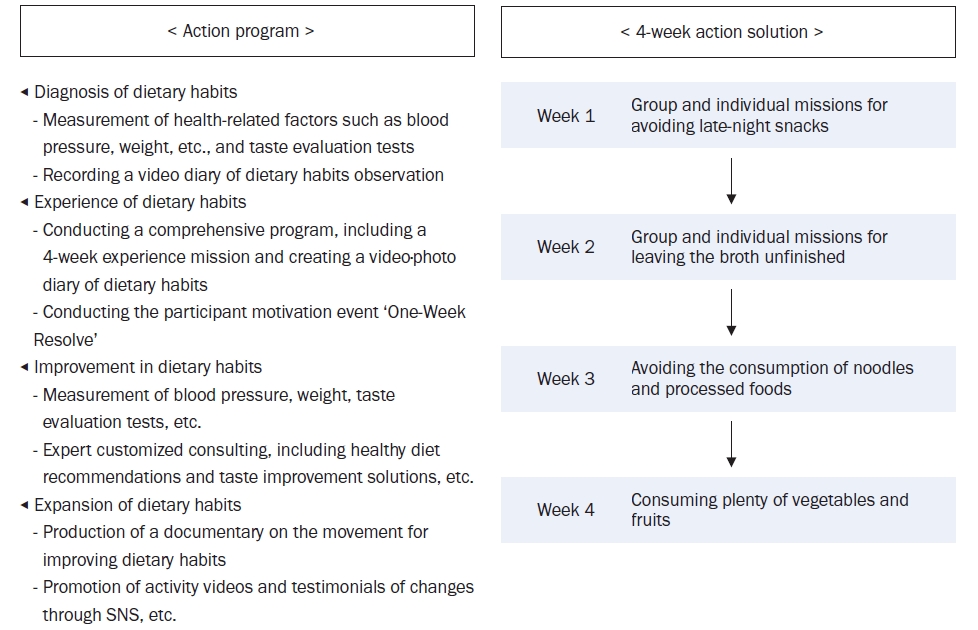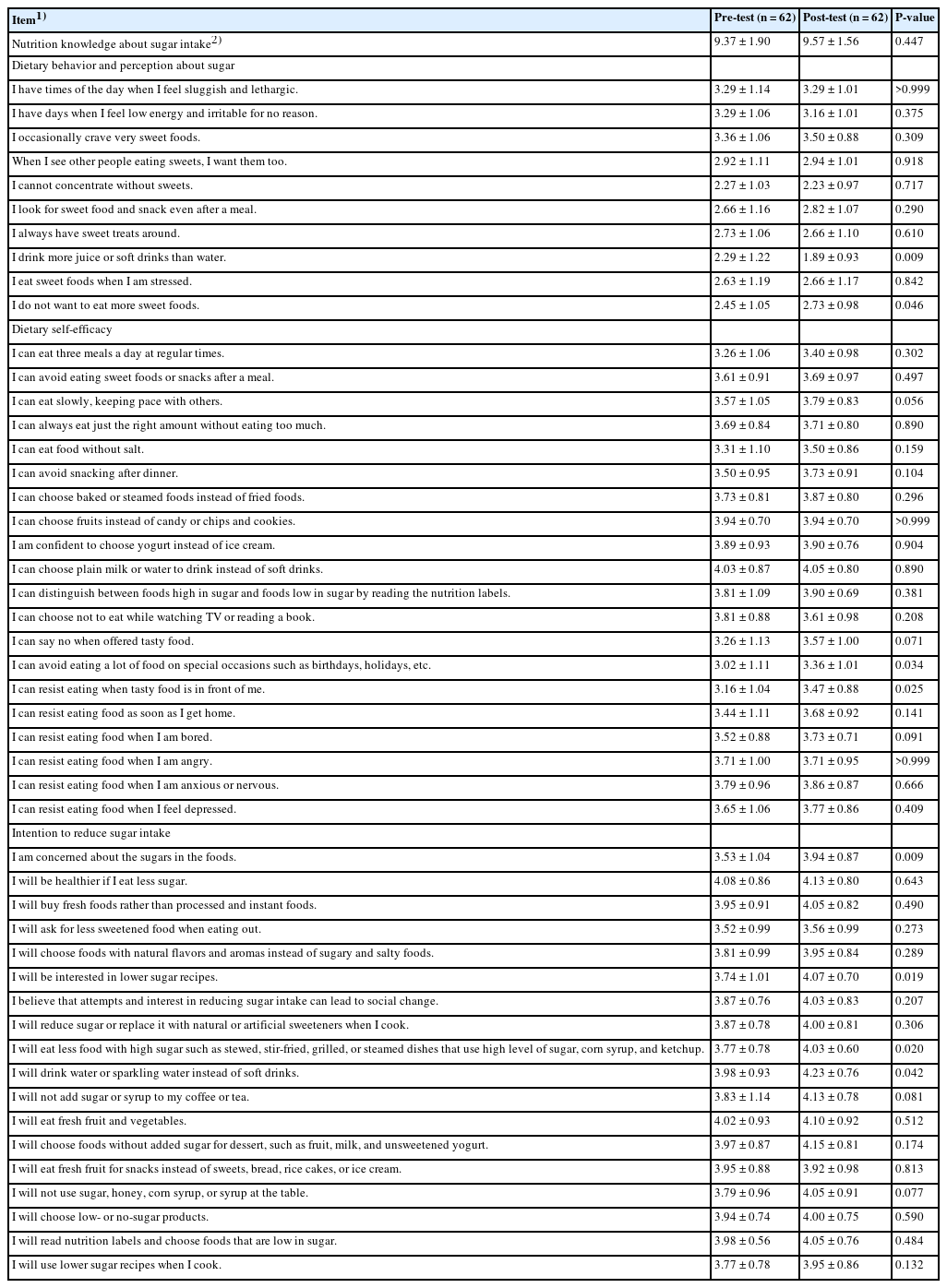- [Korean]
-
Application of a living lab model to an evidence-based reduced-sodium healthy eating practice program in Korea: a pre-post study
-
Jung-Hyun Kim, Eugene Shim, Min Sook Kyung, Sooyoun Kwon, Hyoung Su Park, Jae-Heon Kang
-
Korean J Community Nutr 2025;30(1):53-63. Published online February 28, 2025
-
DOI: https://doi.org/10.5720/kjcn.2024.00346
-
-
 Abstract Abstract
 PDF PDF
- Objectives
To apply a healthy dietary program with reduced sodium intake, developed using data from the Korea National Health and Nutrition Examination Survey (KNHANES), focusing on the sodium intake level and eating patterns.
Methods
The program was implemented using a living lab model, an open innovation ecosystem for user-centered problem-solving. Analysis of the KNHANES data revealed that older age groups had a low energy intake but a high sodium intake, particularly among those who frequently dined out. The program was designed to improve sodium-reduction literacy and enhance practical competency. Over four weeks, 40 participants tracked their dietary intake and worked with a clinical nutritionist through a process of diagnosis, experience, improvement, and expansion. A self-administered survey was conducted before and after the program to assess effectiveness.
Results
Participants were four teenagers (10%), 26 in their twenties (65%), and 10 aged ≥ 30 years (25%), with eight males (20%) and 32 females (80%). Post-program analysis showed significant improvements in sodium-related nutrition knowledge (P < 0.01), with increased agreement on adopting low-sodium intake practices (e.g., interest in sodium content, choosing lower-sodium foods). Nutrient intake analysis showed a decrease in energy, carbohydrates, lipids, and proteins (P < 0.001), with sodium intake decreasing from 3,382.37 mg/d to 2,119.05 mg/d (P < 0.001).
Conclusion
The community-based, living lab model for the sodium-reduction program effectively improved participant sodium-reduction literacy and practical competency, suggesting that step-by-step, autonomous learning, can reduce sodium intake and promote healthier eating habits.
- [Korean]
-
Development and application of a dietary program to reduce sugar intake using a living lab approach in Korea: an intervention study
-
Jung-Hyun Kim, Min Sook Kyung, Seul Ki Choi
-
Korean J Community Nutr 2024;29(6):504-513. Published online December 31, 2024
-
DOI: https://doi.org/10.5720/kjcn.2024.00318
-
-
 Abstract Abstract
 PDF PDF
- Objectives
This study aimed to develop and apply a dietary program to reduce sugar intake among community residents using a Living Lab approach.
Methods
We developed and applied a community-based dietary program to reduce sugar intake. Participants were recruited from community organizations, including a children’s food service management center, elementary to high schools, a university, a family center, a community health center, and an elderly welfare center. The dietary program was conducted in two phases; start and next levels. The start level included a pre-assessment of dietary behaviors and participation in educational platforms, whereas the next level included activities using educational platforms, tailored mission and feedback, and pre- and post-surveys. Extension educators at each community organization implemented the dietary program following organization-specific guidelines. Changes in participants’ nutrition knowledge, dietary behaviors and perceptions, self-efficacy, intention to reduce sugar intake, and participants’ program satisfaction were analyzed using paired t-tests.
Results
In total, 1,238 and 339 individuals participated in the start and next level, respectively. Participants reported significantly lower scores on dietary behavior items regarding drinking more juice or soft drinks after program participation (P = 0.009) and craving sweet foods (P = 0.046). They reported a higher intention to take interest in sugar content in food (P = 0.009) and lower-sugar recipes (P = 0.019), eat less food with high sugar content (P = 0.020), and drink water or sparkling water instead of soft drinks (P = 0.042). Nutrition knowledge did not significantly change after program participation. Program satisfaction significantly increased from the start level to the next level (P<0.050).
Conclusion
This study showed the potential of using a Living Lab approach to implement community-wide dietary interventions. Further research is required to evaluate the effectiveness of the Living Lab approach in various community settings.
- [English]
-
Development and Application of an Education Program for Healthy Dietary Life for Elementary School Aftercare Class Children
-
Jung Hyun Kim, Min Sook Kyung, In Young Park, Young Sim Park
-
Korean J Community Nutr 2019;24(6):497-511. Published online December 31, 2019
-
DOI: https://doi.org/10.5720/kjcn.2019.24.6.497
-
-
 Abstract Abstract
 PDF PDF
- OBJECTIVES
This study aimed to develop a school-centered healthy eating environment for children in elementary care classrooms and prevent incorrect eating habits and obesity through the development and application of standardized healthy eating habit-forming educational materials.
METHODS
Ten schools in eight districts of Gyeonggi-do and 400 students from 19 care classes were selected. Based on the developed educational materials, the program was applied to students once in two weeks. ‘Notices for Parents’ forms were also sent to the students' home to educate their parents. Pre and post-surveys were conducted to evaluate the effectiveness of the education. The pre-education, education, and aftercare were conducted from September 28 to September 31, 2016, from October 3 to November 30, 2016, and from December 5 to December 9, 2016, respectively.
RESULTS
The healthy eating program for elementary care classes was designed to develop a school-centered healthy eating environment and provide standardized educational material for healthy eating habits. Twelve educational topics were developed: 〈Eat Evenly〉, 〈Eat Breakfast〉, 〈Eat vegetables and Fruits〉, 〈Clean Body, Strong Body〉, 〈Healthy and Tasty Snacks〉, 〈Keep Healthy Weight〉, 〈Food that enters our body〉, 〈What is safe food?〉, 〈Food selection and Storage〉, 〈Our land, Our grain〉, 〈Enjoy Traditional Food〉, and 〈Food manners〉. Moreover, the materials were produced in four forms: for students, for after school caring teachers, for external specialists, and for parents. The effectiveness evaluation was conducted to confirm the application of the program. The average eating habits score was 3.3 ± 0.6, with no significant difference between before and after application. The score of overall satisfaction of the education was 3.9 ± 0.9. The most satisfying content was ‘Did you get to know how to eat evenly?’. Significant increases were observed in two contents for parents regarding their children's knowledge changes after the education: ‘Five nutrients needed for growing children’ and ‘Knowing sugar foods and sugar-containing foods’. On the other hand, their educational satisfaction was 3.6 ± 0.6, which was lower than the children's satisfaction. This might be because their education was conducted only through the ‘Notices for Parents’ form.
CONCLUSIONS
In the long term, the healthy eating habit-formation education for lower elementary school children is expected to be beneficial. To prevent obesity and establish healthy eating habits of children, it is important to develop healthy eating education programs centered on elementary school aftercare classes, including the development of educational materials and an application system through connection with the home and community.
-
Citations
Citations to this article as recorded by  - An Interactive Live and Online Cooking Program for Children in Vulnerable Families—An Exploratory Study
Jiyoung Park, Sein Hwang, Seolhyang Baek, Gill A. Ten Hoor
Healthcare.2022; 10(12): 2389. CrossRef
-
1,239
View
-
6
Download
-
1
Crossref
- [English]
-
Milk Intake Patterns with Lactose and Milk Fat in Korean Male Adults
-
Jung Hyun Kim, Min Sook Kyung, Sung Hee Min, Myung Hee Lee
-
Korean J Community Nutr 2018;23(6):488-495. Published online December 31, 2018
-
DOI: https://doi.org/10.5720/kjcn.2018.23.6.488
-
-
 Abstract Abstract
 PDF PDF
- OBJECTIVES
This study examined the milk intake patterns with lactose and milk fat in Korean male adults using the following variables: milk intake level, awareness of lactose, and milk fat, health problems, and necessity of milk intake. In addition, the factors affecting milk intake were analyzed by multiple regression analysis.
METHODS
The subjects were 532 males aged 20 years or older among the nationwide milk purchasing group. The subjects were 223 (41.9%) in the 20–29 year age group, 188 (35.3%) in the 30–49 year age group and 121(22.7%) in the over 50 year age group. The survey was conducted using ANOVA and multiple comparative analysis to examine the differences in age and multiple regression analysis was performed to investigate the factors affecting the intake of milk.
RESULTS
The intake of milk in the subjects was 538.14 ± 494.23 ml per week. There were statistically significant differences in the subjects' age according to processed milk, low fat, nonfat milk, cheese, and ice cream. The perception of milk and lactose and milk fat was recognized as a good food for skeletal health when milk was consumed. Among the milk nutrients, lactose was highly recognized at the age of 20–29, and milk fat was recognized in those over 50 years. In addition to lactose and milk fat, calcium was the most highly recognized among the milk nutrients. Health problems associated with milk were skeletal health, obesity, and lactose intolerance. The perception of lactose intolerance was related to lactose intolerance and fatness, and the dietary behavior was unaffected.
CONCLUSIONS
This study examined the milk intake patterns of adult Korean males. Many variables were found to be related to the intake of milk. In this study, the milk intake was high when there was no problem with the perception and dietary behaviors of milk nutrition (lactose and milk fat). This study focused on lactose and milk fat, which are major nutrients in milk, and it is a new perspective study among milk-related research.
-
Citations
Citations to this article as recorded by  - Association of milk and dairy product consumption with the incidence of cardio-cerebrovascular disease incidence in middle-aged and older Korean adults: a 16-year follow-up of the Korean Genome and Epidemiology Study
Yeseung Jeong, Kyung Won Lee, Hyekyeong Kim, Yuri Kim
Nutrition Research and Practice.2023; 17(6): 1225. CrossRef
-
1,629
View
-
0
Download
-
1
Crossref
- [English]
-
Comparison Between Semi-Quantitative Frequency Methods and 7-day Dietary Records Methods in Food and Nutrition Intake Status For Hemodialysis Patients
-
Dong Ryeol Ryu, Jung Hyun Kim, Hyun Jung Kim, Min Sook Kyung, Jung Tak Park
-
Korean J Community Nutr 2017;22(5):426-440. Published online October 31, 2017
-
DOI: https://doi.org/10.5720/kjcn.2017.22.5.426
-
-
 Abstract Abstract
 PDF PDF
- OBJECTIVES
The valid assessment of food and nutrients intakes using appropriate dietary intake method is necessary to improve the nutritional status of the hemodialysis (HD) patients. This study was conducted to compare the method between newly developed, semi-quantitative food frequency questionnaire (Semi-FFQ) and 7-day dietary records (7-DRs) for hemodialysis patients.
METHODS
We conducted both methods on 53 maintenance HD patients in two university hospitals. We calibrated the frequency, portion size and daily intake of 47 food items reported in Semi-FFQ. The food and nutrients intake was compared and the correlation of the two methods was analyzed. Also each nutrient intake was compared to recommended dietary allowance for Korean (KDRIs) and recommended nutrient reference value for HD patients.
RESULTS
Energy and energy-yielding nutrients intakes were significantly higher in the two methods (p<0.01). These support the possible reliability between Semi-FFQ and 7-DRs that is similar with regard to most mineral and vitamin intakes. Thus, the Semi-FFQ used in this study for the assessment of nutrient intakes of HD patients can be reliable for the assessment of the nutrient intake along with the 7-DRs. The correlation coefficients were higher for foods consumed daily, such as steamed rice, meat and chicken, bean, egg, milk, coffee and alcohol than for those of foods eaten rarely (p<0.01).
CONCLUSIONS
The Semi-FFQ used in this study can be a reliable tool for the assessment of the HD patients' nutrient intake along with the 7-DRs, despite its limitations.
-
Citations
Citations to this article as recorded by  - Comparison of dietary intake patterns in hemodialysis patients by nutritional status: A cross-sectional analysis
Ji Eun Lee, Hyun-Jung Kim, Mi Jung Lee, Young Eun Kwon, Min-Sook Kyung, Jung-Tak Park, Jung Pyo Lee, Su-Hyun Kim, Jung-Hyun Kim, Hyung Jung Oh, Dong-Ryeol Ryu
Kidney Research and Clinical Practice.2020; 39(2): 202. CrossRef - Comparison of hemodialysis and peritoneal dialysis patients’ dietary behaviors
Seon-Mi Kim, Byung Chin Kang, Hyun-Jung Kim, Min-Sook Kyung, Hyung Jung Oh, Jung-Hyun Kim, Oran Kwon, Dong-Ryeol Ryu
BMC Nephrology.2020;[Epub] CrossRef
-
1,121
View
-
1
Download
-
2
Crossref
|














